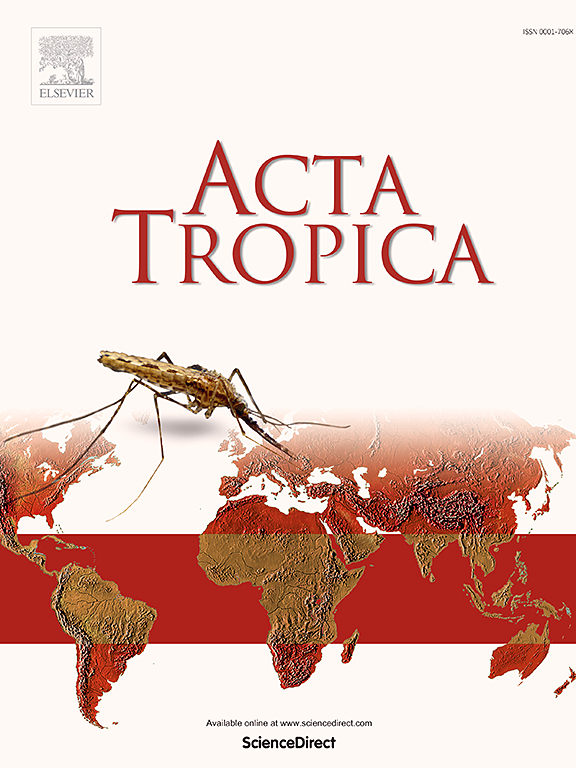Epidemiology, diagnostic methods, and available treatments for tinea capitis in Ethiopia: A narrative review
IF 2.1
3区 医学
Q2 PARASITOLOGY
引用次数: 0
Abstract
Tinea capitis is a common fungal infection of the skin and hair follicles of the scalp, primarily affecting the pediatric population. It is caused by dermatophytes, mainly from the Trichophyton and Microsporum genera, and clinical diagnosis can be confirmed through microscopic examination, culture, or molecular techniques. Adequate treatment should involve systemic antifungal drugs. Ethiopia, the second most populous country in Africa, also reports the second-highest prevalence of tinea capitis on the continent. However, fungal diseases remain largely neglected in public health initiatives. This narrative review aims to synthesize current epidemiological data, risk factors, and diagnostic and therapeutic approaches, to estimate the disease burden, guide clinical practice, and inform future public health strategies. A systematic literature search was conducted in open-access databases. Data on study populations, prevalence, risk factors, diagnosis, and treatment were extracted and analyzed. A total of 14 studies were included, encompassing 7077 patients with tinea capitis in Ethiopia. The condition was found to be highly prevalent among Ethiopian children, mirroring trends seen in other African regions. The predominance of urban-based studies reveals a critical gap in data from rural areas, limiting a full understanding of the national disease burden. Clinical diagnosis alone may overestimate prevalence, potentially leading to inappropriate treatments and increased antifungal resistance. Transmission is strongly influenced by socioeconomic and hygiene-related factors. Trichophyton species are the main etiological agents. While national efforts have improved hygiene and sanitation, significant challenges persist. Moreover, despite the existence of diagnostic and treatment guidelines, their uneven application, often due to economic and logistical constraints, continues to hinder effective disease management.

埃塞俄比亚头癣的流行病学、诊断方法和可用治疗:叙述性回顾
头癣是一种常见的真菌感染的皮肤和头皮毛囊,主要影响儿科人群。它是由皮肤真菌引起的,主要来自毛癣菌属和小孢子菌属,临床诊断可通过显微镜检查、培养或分子技术来证实。适当的治疗应包括全身抗真菌药物。埃塞俄比亚是非洲人口第二多的国家,也是非洲大陆上头癣发病率第二高的国家。然而,真菌病在公共卫生行动中基本上仍然被忽视。本综述旨在综合当前流行病学数据、危险因素以及诊断和治疗方法,评估疾病负担,指导临床实践,并为未来的公共卫生战略提供信息。在开放存取数据库中进行了系统的文献检索。提取并分析了研究人群、患病率、危险因素、诊断和治疗方面的数据。共纳入14项研究,涉及埃塞俄比亚7077例头癣患者。发现这种情况在埃塞俄比亚儿童中非常普遍,反映了非洲其他地区的趋势。以城市为基础的研究占主导地位,这表明农村地区的数据存在严重差距,限制了对国家疾病负担的充分了解。单独的临床诊断可能高估患病率,可能导致不适当的治疗和增加抗真菌耐药性。传播受到社会经济和卫生相关因素的强烈影响。毛癣菌是主要的病原。虽然国家努力改善了个人卫生和环境卫生,但重大挑战依然存在。此外,尽管存在诊断和治疗准则,但往往由于经济和后勤方面的限制,这些准则的应用不均衡,继续阻碍有效的疾病管理。
本文章由计算机程序翻译,如有差异,请以英文原文为准。
求助全文
约1分钟内获得全文
求助全文
来源期刊

Acta tropica
医学-寄生虫学
CiteScore
5.40
自引率
11.10%
发文量
383
审稿时长
37 days
期刊介绍:
Acta Tropica, is an international journal on infectious diseases that covers public health sciences and biomedical research with particular emphasis on topics relevant to human and animal health in the tropics and the subtropics.
 求助内容:
求助内容: 应助结果提醒方式:
应助结果提醒方式:


